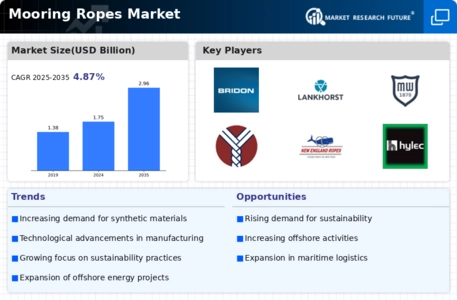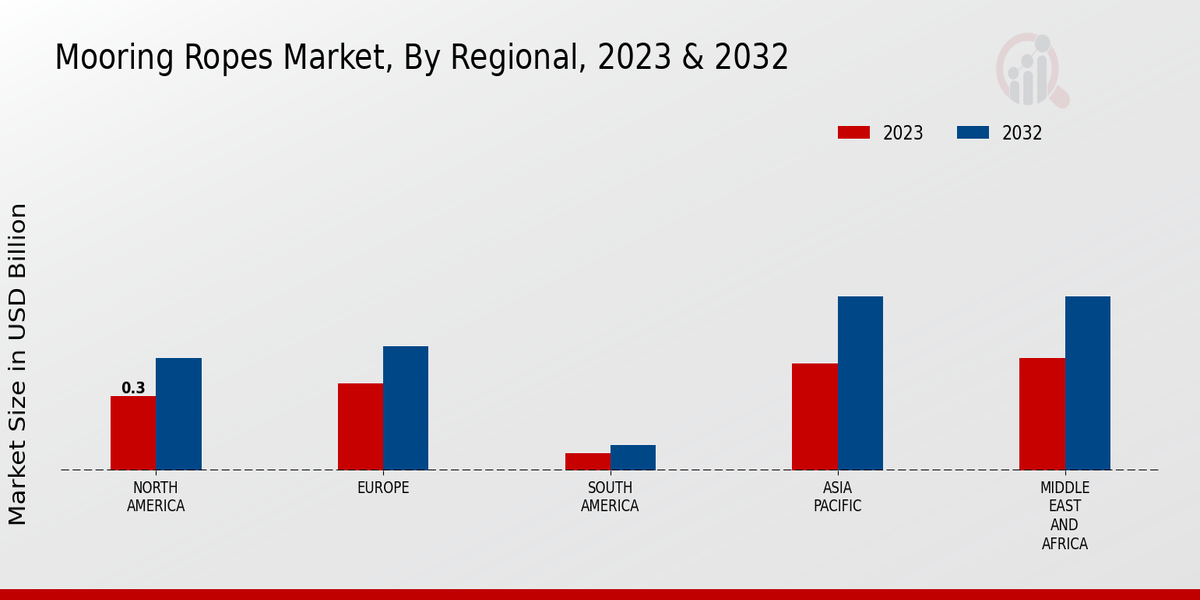Market Size Projections
The Global Mooring Ropes Market Industry is poised for substantial growth, with projections indicating a market size of 1.75 USD Billion in 2024 and an anticipated increase to 2.96 USD Billion by 2035. This growth trajectory suggests a compound annual growth rate (CAGR) of 4.89% from 2025 to 2035. Such figures reflect the industry's resilience and adaptability in response to evolving market dynamics. Factors contributing to this growth include rising maritime activities, technological advancements, and increasing environmental regulations. The market's expansion is indicative of the critical role that mooring ropes play in ensuring the safety and efficiency of maritime operations.
Increasing Environmental Regulations
The Global Mooring Ropes Market Industry faces a growing influence from environmental regulations aimed at promoting sustainable maritime practices. Governments worldwide are implementing stricter guidelines to minimize the ecological impact of shipping and offshore activities. This regulatory landscape encourages the adoption of eco-friendly mooring solutions, such as biodegradable ropes and those made from recycled materials. As companies strive to comply with these regulations, the demand for innovative mooring products that align with sustainability goals is likely to rise. This shift not only enhances the industry's reputation but also opens new avenues for growth and development.
Rising Demand for Marine Transportation
The Global Mooring Ropes Market Industry experiences a notable surge in demand driven by the increasing need for marine transportation. As global trade expands, the reliance on shipping and maritime logistics intensifies. This trend is evidenced by the projected market size of 1.75 USD Billion in 2024, reflecting the industry's growth potential. The expansion of shipping routes and the construction of new ports further contribute to this demand. Consequently, the need for robust and reliable mooring solutions becomes paramount, positioning mooring ropes as essential components in ensuring the safety and efficiency of maritime operations.
Growth of Offshore Oil and Gas Exploration
The Global Mooring Ropes Market Industry is significantly influenced by the growth of offshore oil and gas exploration activities. As energy demands rise, companies are increasingly investing in offshore drilling projects, necessitating reliable mooring solutions for floating platforms and vessels. This sector is projected to contribute substantially to the market, with estimates suggesting a market size of 2.96 USD Billion by 2035. The need for specialized mooring ropes that can withstand harsh marine environments underscores the importance of this segment. Furthermore, regulatory frameworks promoting sustainable practices in offshore operations may drive innovation in mooring technologies.
Expansion of the Recreational Boating Sector
The Global Mooring Ropes Market Industry benefits from the expansion of the recreational boating sector, which has gained popularity in recent years. As more individuals engage in boating activities, the demand for reliable mooring solutions increases. This trend is particularly evident in regions with vibrant coastal tourism, where marinas and docking facilities are proliferating. The recreational boating market's growth contributes to the overall demand for mooring ropes, as boat owners seek high-quality products to ensure the safety of their vessels. This segment is expected to play a crucial role in shaping the industry's future, potentially driving innovation and diversification in mooring solutions.
Technological Advancements in Mooring Solutions
Technological innovations play a pivotal role in shaping the Global Mooring Ropes Market Industry. The introduction of high-performance materials and advanced manufacturing techniques enhances the durability and strength of mooring ropes. For instance, the development of synthetic fibers, such as Dyneema and Kevlar, offers superior resistance to abrasion and environmental factors. These advancements not only improve the performance of mooring ropes but also reduce maintenance costs for operators. As the industry evolves, the integration of smart technologies, such as sensors for monitoring mooring conditions, is likely to further enhance safety and operational efficiency.





















